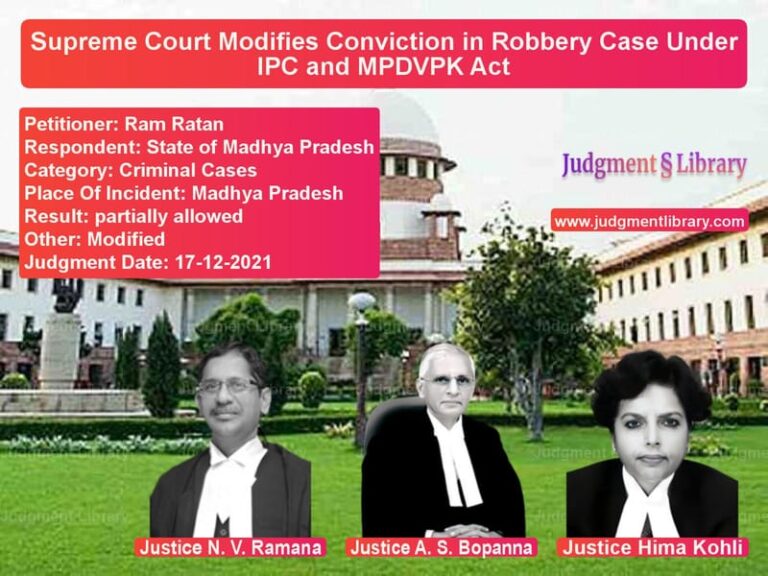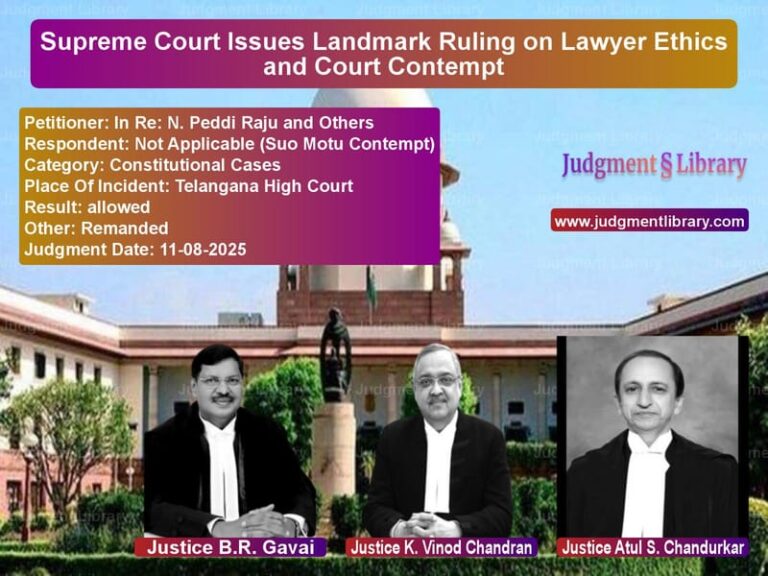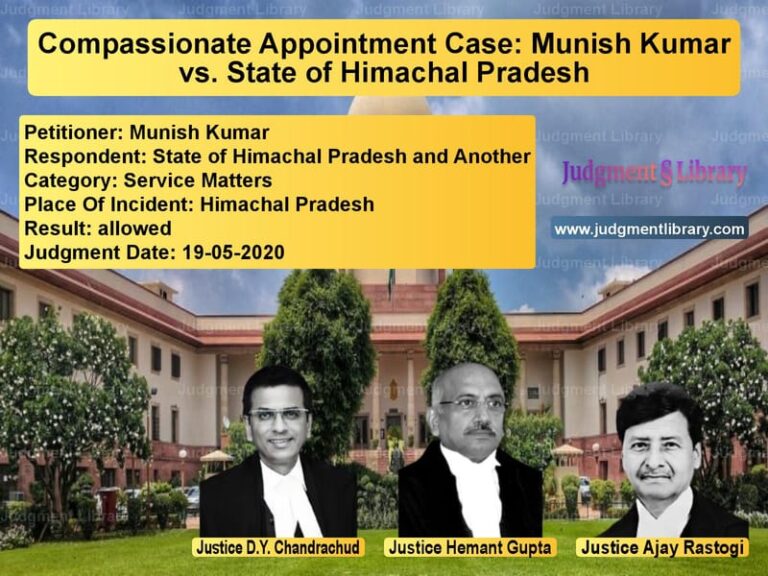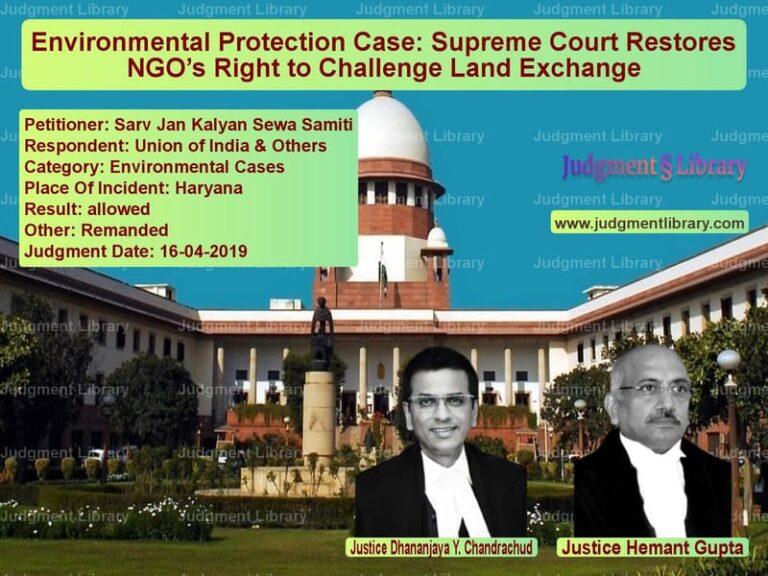Supreme Court Upholds High Court Verdict: Culpable Homicide Conviction for Accused in Madhya Pradesh Murder Case
The Supreme Court of India, in the case of State of Madhya Pradesh vs. Gangabishan @ Vishnu & Ors., upheld the Madhya Pradesh High Court’s judgment modifying the conviction of the primary accused from murder (Section 302 IPC) to culpable homicide not amounting to murder (Section 304 Part I IPC). The Court ruled that the accused did not have the intention to commit murder, but the injury inflicted was likely to cause death. This judgment emphasizes the significance of assessing intent in homicide cases.
Background of the Case
The case originated from an incident where Dinesh (PW-1) and his brother, Rajesh (deceased), were in their agricultural field when they were allegedly attacked by a group of nine individuals. The accused were reportedly armed with weapons such as lathis and swords, except accused No. 1, Gangabishan @ Vishnu, who was carrying a 12-bore gun.
According to the prosecution, a dispute over cattle grazing on their land led to the fatal attack. Rajesh was shot in the thigh by accused No. 1, while Dinesh managed to escape and inform the villagers. Rajesh was later transported to the hospital but succumbed to his injuries.
Trial Court Verdict
The trial court found the accused guilty under Sections 302/149 IPC for murder and sentenced them to life imprisonment. Additionally, the accused were convicted under Sections 325/149 IPC (causing grievous hurt), Section 147 IPC (rioting), Section 148 IPC (rioting with deadly weapons), and Section 440 IPC (mischief committed with preparation to cause death or hurt). Accused No. 1 was also convicted under Section 30 of the Arms Act.
High Court’s Modifications
Upon appeal, the Madhya Pradesh High Court modified the convictions as follows:
- The convictions of accused Nos. 2 to 9 were set aside due to lack of evidence proving their direct involvement in the assault.
- Accused No. 1, Gangabishan @ Vishnu, was found guilty under Section 304 (Part I) IPC instead of Section 302 IPC, considering the nature and location of the gunshot wound.
- The sentence was reduced to 10 years of rigorous imprisonment along with a fine of Rs. 25,000.
Arguments Presented
Arguments by the Prosecution
- The prosecution contended that the accused had arrived at the crime scene with premeditated intent to commit murder.
- It argued that the attack was unprovoked and that accused No. 1 deliberately fired at Rajesh with the intention to kill him.
- The prosecution relied on the dying declaration of Rajesh, which stated that he was shot by accused No. 1 and assaulted by others.
- It was asserted that the High Court erred in reducing the conviction from murder to culpable homicide.
Arguments by the Defense
- The defense argued that the incident stemmed from a dispute over cattle grazing and was not a premeditated attack.
- It contended that Rajesh suffered only a single gunshot wound on his thigh, which was not aimed at a vital organ.
- The absence of injuries from sharp-edged weapons on both Rajesh and Dinesh contradicted the prosecution’s claim that the entire group assaulted them.
- The defense maintained that accused No. 1 did not intend to kill Rajesh, and the evidence supported a conviction for culpable homicide, not murder.
Supreme Court’s Observations
The Supreme Court analyzed the medical and eyewitness evidence and agreed with the High Court’s findings. The Court noted:
“It is clear from the evidence on record that the deceased Rajesh suffered only one injury on the interior aspect of the thigh, which was an exit wound. Injury No. 2 was a gunshot entry wound on the back side of the left thigh. The absence of multiple injuries or wounds on vital organs indicates that the intention was not to kill but to cause bodily harm.”
The Court further observed that the absence of injuries from sharp-edged weapons contradicted the claim of an armed mob attack:
“Neither the deceased nor PW-1 had any injury caused by sharp-edged weapons. The general statement about the participation of all the accused with different weapons and causing injury to the deceased is not duly corroborated by medical evidence.”
The Court emphasized that the nature of the injury indicated that the accused fired the gunshot from a close range but targeted the thigh instead of a vital organ:
“If accused No. 1 intended to kill the deceased, he would have aimed at the upper body rather than the back portion of the left thigh. Thus, though the act was intentional, it falls under culpable homicide not amounting to murder.”
Final Judgment
The Supreme Court ruled:
- The appeal by the State of Madhya Pradesh was dismissed, upholding the High Court’s modification of the conviction.
- Accused No. 1’s conviction under Section 304 (Part I) IPC remained, with a sentence of 10 years of rigorous imprisonment and a fine of Rs. 25,000.
- The acquittal of accused Nos. 2 to 9 was upheld due to lack of sufficient evidence.
Impact of the Judgment
This ruling provides critical insights into the judicial approach to assessing intent in homicide cases:
- It highlights that mere presence at the crime scene does not establish guilt unless supported by strong evidence.
- The judgment reinforces that intent plays a crucial role in differentiating between murder and culpable homicide.
- It underscores the significance of medical evidence in corroborating or contradicting eyewitness testimonies.
- The Court’s reasoning serves as a guiding precedent for future cases involving group violence and homicide.
Conclusion
The Supreme Court’s decision in this case reiterates the necessity of evaluating the intent behind an act before determining the degree of criminal liability. By upholding the High Court’s decision to convict accused No. 1 under Section 304 (Part I) IPC instead of Section 302 IPC, the judgment ensures a fair assessment of the accused’s culpability. This case serves as a vital reference point for similar disputes involving group assaults and firearm-related offenses.
Petitioner Name: State of Madhya Pradesh.Respondent Name: Gangabishan @ Vishnu & Ors..Judgment By: Justice Abhay Manohar Sapre, Justice S. Abdul Nazeer.Place Of Incident: Shajapur, Madhya Pradesh.Judgment Date: 27-07-2018.
Don’t miss out on the full details! Download the complete judgment in PDF format below and gain valuable insights instantly!
Download Judgment: State of Madhya Prad vs Gangabishan @ Vishnu Supreme Court of India Judgment Dated 27-07-2018.pdf
Direct Downlaod Judgment: Direct downlaod this Judgment
See all petitions in Murder Cases
See all petitions in Attempt to Murder Cases
See all petitions in Judgment by Abhay Manohar Sapre
See all petitions in Judgment by S. Abdul Nazeer
See all petitions in dismissed
See all petitions in supreme court of India judgments July 2018
See all petitions in 2018 judgments
See all posts in Criminal Cases Category
See all allowed petitions in Criminal Cases Category
See all Dismissed petitions in Criminal Cases Category
See all partially allowed petitions in Criminal Cases Category







